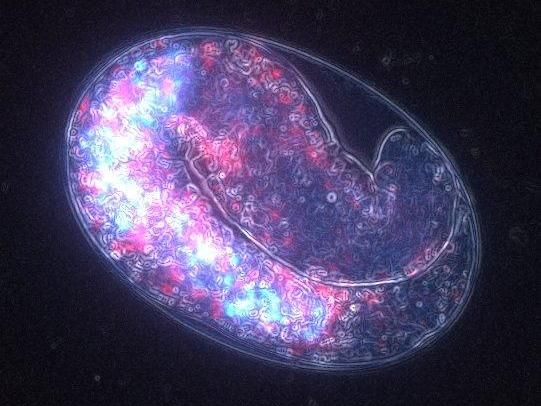Longest case of COVID-19 sheds light on SARS-CoV-2 escape from immune system
Researchers from Skoltech and their colleagues have studied the longest confirmed case of Covid-19 in an immunocompromised patient who was infected for 318 days. The study revealed new ways in which the virus can mutate to escape from cellular immunity.

Symbolic image
Gerd Altmann on Pixabay
This work is a collaborative effort of Skoltech; Smorodintsev Research Institute of Influenza; First Pavlov State Medical University; Parseq Lab Co. Ltd; A.A. Kharkevich Institute for Information Transmission Problems of the Russian Academy of Sciences; Bioinformatics Institute; City Hospital 31 in Saint-Petersburg, Russia; and the Pirogov Russian National Research Medical University.
Ever since the first cases of COVID-19, the novel coronavirus has been mutating constantly as it spreads in the global population. Some of these mutations ultimately give rise to variants of concern that are more transmissible or more deadly, such as the infamous delta variant. But if the virus lingers in one patient long enough, it can also accumulate mutations that help it evade the immune response, turning these immunocompromised patients into unwilling hotspots of rapid viral evolution.
One case of this intra-host evolution that stands out is the case of patient S, a woman with the late-stage Non-Hodgkin's diffuse B-cell lymphoma. She first tested positive for COVID-19 in April 2020, and finally got her definitive negative test almost a year later, in March 2021. As noted by Dr. Oksana Stanevich, the MD who followed up the patient and collected clinical data, she experienced two episodes of severe COVID-19 with fever and pneumonia over the course of the disease.
The comprehensive data allowed the team of researchers including Skoltech Professor Georgii Bazykin to track the evolution of SARS-CoV-2 within the host. Whole-genome sequencing and phylogenetic analysis confirmed that patient S was indeed infected with the same lineage of the virus throughout the disease. There was apparently no onward transmission of the virus from her, judging by the absence of similar samples in GISAID, a global database used to track SARS-CoV-2 variants.
The virus in patient S accumulated a total of 40 mutations, changing much faster than it does in the general population. This rapid evolution indicates that the virus has been adapting within the human body, acquiring mutations that allow it to survive better and/or reproduce faster. A fraction of these changes were in the spike protein; some of them matched those previously found in patients treated with convalescent plasma or monoclonal antibodies, and were implicated in escape from neutralizing antibodies.
However, due to her treatment regimen, patient S had no B-lymphocytes in peripheral blood flow and hardly any IgG antibodies, so her humoral immunity was essentially “disabled.” Moreover, the majority of rapidly gained changes were outside surface proteins. “This was puzzling,” explains Evgeniia Alekseeva, the joint first author of the paper. “Why would the virus hide from something that is not there? And why would it camouflage its parts that antibodies cannot see anyway?”
In search of an explanation, the researchers turned to the other major mechanism of immunity: the one driven by killer T-cells, the cytotoxic weapons of cell-mediated immunity. This system does not involve antibodies and remained functional in the patient. Escape from T-cell mediated immunity in SARS-CoV-2 has previously gained comparatively little attention. While humoral immunity primarily targets surface proteins such as spike, any peptide encoded by the viral genome can theoretically be recognized by T-cells; thus, mutations allowing escape from T-cell immunity can be found in any viral gene. Therefore, the research team hypothesized that SARS-CoV-2 infecting patient S may have evolved specifically to evade the only defense system it faced.
To test this, the researchers computationally and experimentally predicted the effects of accumulated mutations on the effectiveness of antigen presentation by the particular HLA alleles (immune genes that are usually different from one individual to the next) encoded by the genome of patient S. “What we saw was striking,” says Evgeniia Alekseeva. “The mutations accumulated by the virus specifically evaded antigen presentation by the HLA alleles of our patient, rendering the T-cell response inefficient.”
These findings show that T-cell escape is an underappreciated and potentially powerful driver of SARS-CoV-2 in patients with compromised immunity. But what does it mean for the pandemic at large? “Consider the SARS-CoV-2 variants of concern that have recently spread widely and gained notoriety," says Georgii Bazykin. "There is something peculiar about their origins. When such a variant originates, it often accumulates multiple mutations rapidly, just as it does when evolving in immunosuppressed individuals. This has led people to suggest that such individuals can be a sort of a gym for the virus where it gains the traits needed to infect humans better. While the virus we studied probably never got out of the gym, our findings imply that the gym equipment is more diverse than we thought.”























































